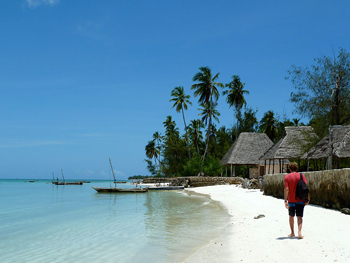Spice islands of Zanzibar
Few places evoke such romance as the fabled spice islands of Zanzibar, Pemba and Mafia -sleepy islands with beautiful unspoilt beaches and lush tropical vegetation. These exotic islands are one of the be st honeymoon destinations and also make for a relaxing African beach holiday.romance, mystery, stunning beache.
st honeymoon destinations and also make for a relaxing African beach holiday.romance, mystery, stunning beache.
The very name brings to mind intrigue, adventure on the high seas and tales of pirates and traders. Today, the “Spice Island” retains all of its romance and mystery and combines it with a collection of boutique accommodation that make it a perfect place to unwind and relax.
Existing ruins comprise of 15th to 19th Century palaces, towns and mosques. Many an explorer stayed on in Zanzibar and the houses where Livingstone and Burton lived can still be seen today.
Zanzibar Stone Town
The sun begins to dissolve into the horizon, perfecting a sweep of unknown orange against pure pale blue, and Stone Town stirs with the wakefulness of night.
Muezzins in their different mosque towers call the faithful to prayers again, dogs bark and children shout as they play football in open corners or dive into the harbour waters and demonstrate feats of bravery with their friends. A crowd starts to gather along the harbour front and in Forodhani Gardens, where smoke is beginning to rise from barbecues at the assorted food stalls and the curio markets are assembling by gaslight amid a hubbub of banter and chat…
This old city remains a living monument to the culture and histories of its curious mix of East African, Arab, Indian, Persian and European conquerors, traders and seafarers, and continues to thrive as a commercial centre.
The ancient maze of narrow streets is a romantic hotchpotch of historic old stone buildings built close for cool respite from the tropical island sun, and shaded by elegantly carved balconies, loggias and verandas that cling precipitously overhead – close enough to catch a whisper, or a kiss.
Now these buildings are homes and hotels, restaurants, guesthouses, offices and shops, whose stone and wood walls remain the backdrop for tropical Arabian-style nights, cloaked women heavily scented with spice and illicit romances eluding the boundaries of a strict social code.
Houses of the most wealthy and influential are built from coral stone, in the Arabic style, usually contained within a walled central courtyard accessed through one grand door. The door, being all that could be seen from outside, was considered the outward expression of the wealth and standing of the household within, and often was built first..
Zanzibar Beaches
The best beaches on Zanzibar Island are to the North and East, where the sun shines on luminescent clear waters in a range of striking turquoise blues, and the sand is clean and bright and fine.
The island is surrounded by rich coral reef, which protects the shoreline and also results in wide flat shallows that are invariably subject to tidal extremes.
The northern peninsula of Zanzibar is truly stunning, and for anyone with a passion for beaches it has all the elements of paradise. It is hard to imagine any traveller arriving on a fine day without a gasp of admiration for the startling translucent waters washing over fine coral sands and wide views across the Indian Ocean.
Here, on the northernmost tip of Zanzibar Island, the air feels fresh from its wide sea crossing and so susceptible to the slightest nuance and reflection as the sun rises and sets. The sand shores up against the land in unfeasibly fine, sinkable pale drifts, and the beach makes its changing way around the headland, depending on the tide.
When the tide is out, the way is opened to walk the long distances exposed and bathe in shallow pools left warming in the sand. Crabs scuttle among the odd flotsam of shells and shapely coral, and colourful women sing and chatter together as they gather around their wide fishing nets, fully clothed and knee-deep in pale turquoise waters to survey their days catch.
Best time for a Zanzibar Beach Holiday:
Late December, January and February is Zanzibar’s short dry season and the hottest time of year. It’s normally around 29°C but can get as hot as 39°C. The weather is very calm, humid and the ocean is flat like a mirror.
April-May is the time when heavy rain is most likely. If you do not mind sheltering when there is a torrential downpour it can be a magical time to be here, as the earth and wildlife heaves a sigh of relief as its thirst is quenched.
June to September is the coolest driest time of year. In July the Kusini trade winds may sometimes bring leaden skies and wild spectacular seas. But they also bring humpback whales,the best chances to see them are July, August, September.
September to December brings the short rains. These rains are usually much lighter and the sunny intervals much longer than is the long rains. The weather and ocean are clear and calm.




